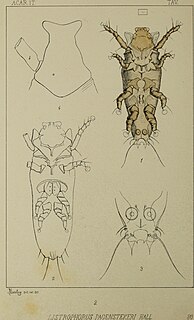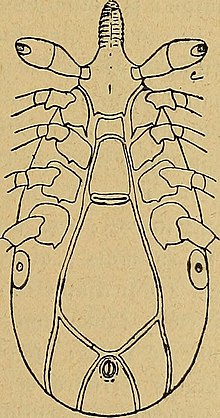Tick paralysis is the only tick-borne disease that is not caused by an infectious organism. The illness is caused by a neurotoxin produced in the tick's salivary gland. After prolonged attachment, the engorged tick transmits the toxin to its host. The incidence of tick paralysis is unknown. Patients can experience severe respiratory distress.

Ixodiphagus hookeri, the tick wasp, is an encyrtid wasp which lays its eggs into ticks. It seems to use a symbiotic bacteria, Wolbachia pipientis, to weaken the tick's immune system.
"Candidatus Midichloria" is a candidatus genus of Gram-negative, non-endospore-forming bacteria, with a bacillus shape around 0.45 µm in diameter and 1.2 µm in length. First described in 2004 with the temporary name IricES1, "Candidatus Midichloria" species are symbionts of several species of hard ticks. They live in the cells of the ovary of the females of this tick species. These bacteria have been observed in the mitochondria of the host cells, a trait that has never been described in any other symbiont of animals.
Powassan virus (POWV) is a Flavivirus transmitted by ticks, found in North America and in the Russian Far East. It is named after the town of Powassan, Ontario, where it was identified in a young boy who eventually died from it. It can cause encephalitis, an infection of the brain. No approved vaccine or antiviral drug exists. Prevention of tick bites is the best precaution.

The discipline of medical entomology, or public health entomology, and also veterinary entomology is focused upon insects and arthropods that impact human health. Veterinary entomology is included in this category, because many animal diseases can "jump species" and become a human health threat, for example, bovine encephalitis. Medical entomology also includes scientific research on the behavior, ecology, and epidemiology of arthropod disease vectors, and involves a tremendous outreach to the public, including local and state officials and other stake holders in the interest of public safety.

Ixodes is a genus of hard-bodied ticks. It includes important disease vectors of animals and humans, and some species inject toxins that can cause paralysis. Some ticks in this genus may transmit the pathogenic bacterium Borrelia burgdorferi responsible for causing Lyme disease. Additional organisms that may be transmitted by Ixodes are parasites from the genus Babesia, which cause babesiosis, and bacteria from the related genus Anaplasma, which cause anaplasmosis.

Ixodes scapularis is commonly known as the deer tick or black-legged tick, and in some parts of the US as the bear tick. It was also named Ixodes dammini until it was shown to be the same species in 1993. It is a hard-bodied tick found in the eastern and northern Midwest of the United States as well as in southeastern Canada. It is a vector for several diseases of animals, including humans and is known as the deer tick owing to its habit of parasitizing the white-tailed deer. It is also known to parasitize mice, lizards, migratory birds, etc. especially while the tick is in the larval or nymphal stage.
Stenoponia americana is a species of large flea in the family Hystrichopsyllidae. It is widespread in North America east of the Great Plains and is found mainly on rodents, notably deermice (Peromyscus) and voles (Microtus). In Missouri, it has been recorded on the fox squirrel, brush mouse, cotton mouse, prairie vole, woodland vole, and white-footed mouse. Hosts recorded in Tennessee include the northern short-tailed shrew, woodland vole, white-footed mouse, hispid cotton rat, marsh rice rat, and house mouse. In South Carolina, recorded hosts include the cotton mouse, hispid cotton rat, and marsh rice rat.

Amblyomma maculatum is a species of tick in the genus Amblyomma. Immatures usually infest small mammals and birds that dwell on the ground; cotton rats may be particularly favored hosts. Some recorded hosts include:
Euschoengastia peromysci is a mite in the genus Euschoengastia of the family Trombiculidae. Recorded hosts include the cotton mouse and marsh rice rat in Georgia; the northern short-tailed shrew, northern red-backed vole, northern flying squirrel, rock vole, white-footed mouse, and deermouse in Tennessee; and northern red-backed vole, southern bog lemming, masked shrew, and eastern red squirrel in North Carolina, among others.
Euschoengastia setosa is a mite in the genus Euschoengastia of the family Trombiculidae that mostly parasitizes small rodents and lagomorphs. Recorded hosts include marsh rice rat in Georgia; the deermouse in Tennessee; and the eastern red squirrel in North Carolina, among others.
Eutrombicula batatas is a species of chigger.

Haemogamasus is a genus of mites in the family Haemogamasidae. In North America, they mostly infect rodents, in addition to other small mammals such as shrews, talpids, and Virginia opossums.
Ixodes affinis is a species of tick in the genus Ixodes. Some reported hosts are:
Ixodes brunneus is a species of tick in the genus Ixodes. It is normally a parasite of birds, but has also been recorded on the marsh rice rat.
Ixodes cookei is a species of tick in the genus Ixodes. It is normally a parasite of carnivorans, such as raccoons, foxes, and weasels, but has also been recorded on the groundhog and the marsh rice rat. In the northeastern United States, it is a vector of Powassan virus.
Ixodes texanus is a species of ticks in the genus Ixodes. It mainly infects raccoons, but has also been recorded on the marsh rice rat in Georgia.

Listrophoridae is a family of mites in the suborder Psoroptidia of the order Sarcoptiformes. The family contains small, long mites specialized for grasping the hairs of mammals. North American genera include:
Prolistrophorus bakeri is a parasitic mite in the genus Prolistrophorus. Together with the Argentine P. hirstianus, it forms the subgenus Beprolistrophorus. P. bakeri has been found on the hispid cotton rat, marsh rice rat, and cotton mouse in Georgia, South Carolina, Texas, and Florida and on Oryzomys couesi in Colima. It was formerly placed in the genus Listrophorus.







